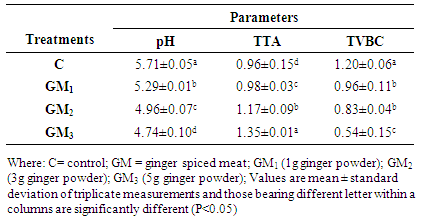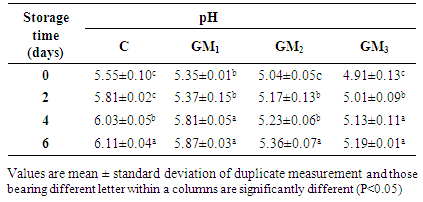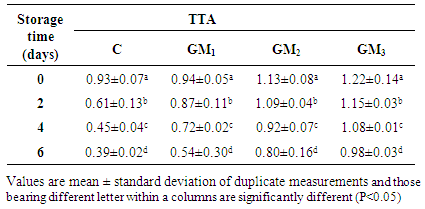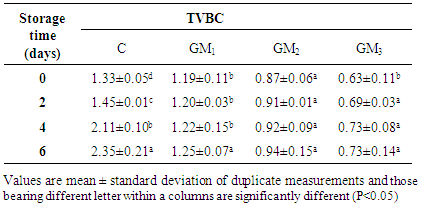-
Paper Information
- Paper Submission
-
Journal Information
- About This Journal
- Editorial Board
- Current Issue
- Archive
- Author Guidelines
- Contact Us
International Journal of Food Science and Nutrition Engineering
p-ISSN: 2166-5168 e-ISSN: 2166-5192
2017; 7(2): 38-42
doi:10.5923/j.food.20170702.03

Effect of Ginger (Zingiber officinale) Powder Addition on pH, Titratable Acidity and Total Viable Bacterial Counts of Minced Meat under Refrigerated Storage
Zemenu Kerie Terefe
School of Nutrition, Food Science and Technology, Hawassa University, Hawassa, Ethiopia
Correspondence to: Zemenu Kerie Terefe, School of Nutrition, Food Science and Technology, Hawassa University, Hawassa, Ethiopia.
| Email: |  |
Copyright © 2017 Scientific & Academic Publishing. All Rights Reserved.
This work is licensed under the Creative Commons Attribution International License (CC BY).
http://creativecommons.org/licenses/by/4.0/

Microbial growth, color changes as well as higher pH than normal are the major problems causing shortening the shelf life of meat and meat products. The effect of different ginger powder concentrations ranged between 0% and 5% on pH, total titratable acidity and total viable bacterial count of minced meat samples were studied during 6 days storage period. Four treatments labeled as; treatment 1 or control (C), treatment 2 (GM1), treatment 3 (GM2) and treatment 4 (GM3) were prepared with 0%, 1%, 3% and 5% ginger powder addition on minced meat samples respectively. Then pH, total titratable acidity (TTA) and total viable bacterial count (TVBC) of four treatment samples were assessed at 0, 2, 4 and 6 storage period. The mean values of pH were decreased from 5.71 to 4.74 where as TTA increased from 0.96 to 1.35 with the addition of ginger powder. The TVBC also decreased from 1.20 to 0.54 with log10 CFU/g calculation. However, when the storage period increased from 0 to 6 days, the treated samples with ginger powder did not showed more changes in terms of pH, TTA and TVBC compared to control samples. The overall results of the current study revealed that ginger powder addition has positive impacts on the shelf life and keeping quality of meat samples.
Keywords: Ginger Powder, Keeping Quality, Meat, Safety, Shelf-life
Cite this paper: Zemenu Kerie Terefe, Effect of Ginger (Zingiber officinale) Powder Addition on pH, Titratable Acidity and Total Viable Bacterial Counts of Minced Meat under Refrigerated Storage, International Journal of Food Science and Nutrition Engineering, Vol. 7 No. 2, 2017, pp. 38-42. doi: 10.5923/j.food.20170702.03.
Article Outline
1. Introduction
- Meat and meat products are concentrated and easily available source of nitrogenous compounds, and is a good source of first class protein which is essential for human life. They supply easily absorbed iron and assist in the absorption of iron from other foods as well as zinc, and are rich sources of some of the B- complex vitamins [1]. However, meat and meat products are highly perishable and have a short shelf-life unless preservation methods are used [2]. This is due to the fact that, these products provide the nutrients needed to support the growth of many types of microorganisms. Moreover, the chemical composition and physical characteristics of meat makes it a suitable environment for bacterial growth [3]. Refrigeration storage is usually the most common method for preservation of fresh meat and meat products [4-6]. A lot of studies have been done so far to preserve meat and meat products using modern and traditional techniques [7]. For instance, in order to extend refrigerated storage time, antimicrobial and antioxidant additives especially those of synthetic origin are added to beef products [8]. However, consumers are increasingly demanding use of natural products as alternative preservatives in foods, as the safety of synthetic additives has been an issue for most of the communities [9, 10]. Natural antioxidants are reported to be more powerful than the synthetic once [11-13]. Ginger is a popular spice for a variety of food stuffs as a food seasoning and flavoring agents due to its sweet aroma and pungent taste [14]. Ginger contains up to 3% of an essential oil that causes the aroma of the spice [15]. Gingerol increase the motility of the gastrointestinal tract and have analgesic, sedative and antibacterial properties [16]. Moreover, different scholars revealed that ginger has antioxidant and antimicrobial activity in different foods [17-19]. Therefore, the objective of this study was to examine the effects of ginger powder addition on pH, TTA and TVBC of minced meat samples.
2. Materials and Methods
2.1. Sample Collection and Preparation
- Ginger samples (3 kg) were purchased from local markets of Hawassa city, Ethiopia. Red meat samples (4 kg) were taken from butchery shops. Minced meat samples were prepared at food chemistry and microbiology laboratory of College of Agriculture, Hawassa University, Hawassa, Ethiopia.
2.1.1. Preparation of Ginger Powder
- Ginger powder was prepared as shown in Figure 1 with major modification of the methods used by [20, 21]. The amount of temperature and time taken were modified in the current study after pre-test.
 | Figure 1. Ginger powder preparation |
2.1.2. Treatment Preparation
- After preparing the ginger powder and minced meat samples, four treatments including the control, 100 g of each were prepared in accordance to [22] with modification of ginger powder amount. Control (C) sample was prepared without ginger powder addition. The rest three treatments labeled as; GM1, GM2 and GM3 were prepared with 1%, 3% and 5% ginger powder addition respectively. The ginger powder proportions were made with the basis of [20].
2.2. Determination of pH and Total Titratable Acidity (TTA)
- The amount of pH for prepared treatments was measured using a digital pH meter. The pH meter was calibrated using buffer of pH (4.0 and 7.0). Ten gram of sample from the prepared treatment was taken aseptically and homogenized with 10 ml of distilled water [8]. The water was drained and pH measurements were taken in triplicates. Ten grams of each sample were magnetically stirred in a total volume of 100 ml distilled water for 30 min, and filtered. Then 10 ml filtrate was titrated with 0.1 M of NaOH using three drops of phenolphthalein as indicator. The titratable acidity was calculated as 1.0 ml of 0.1 M NaOH = 0.0090 g lactic acid [21].
2.3. Determination of Total Viable Bacterial Count (TVBC)
- Serial dilutions were prepared for the total viable bacterial count as follows: Thirty grams from each treatment sample was shaken thoroughly with 270 ml distilled water to give 10−1 dilution. A set of four tubes containing 9 ml distilled water was prepared and 1 ml of the suspension was transferred to each tube up to 10-6 dilution order. For the determination of TVBC, 1 ml aliquots from each dilution were transferred aseptically into sterile petri-dishes and 10-15 ml of molted and cooled agar was added. Inoculums was mixed well with the medium and allowed to solidify. The plates were then incubated in an incubator at 37°C for 24 hours. Then enumeration of total microbial counts was done.
2.4. Statistical Analysis
- One way analysis of variance (ANOVA) with complete randomized design (CRD) was carried out to study the effects of ginger powder addition on the pH, TTA and TVBC of minced meat samples. Statistical software package of SAS version 9.01 was used. The results were expressed as mean ± standard deviation. The mean separation technique was carried out using Fisher’s LSD (least significant difference) at P<0.05 level of significance.
3. Results and Discussion
3.1. Total Titratable Acidity, pH and Total Viable Bacterial Count
- The values of TTA, pH and TVBC of minced meat samples spiced with ginger are presented in Table 1.
|
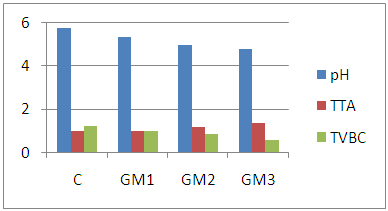 | Figure 2. pH, TTA and TPC versus ginger powder spiced meat |
3.2. Change in pH with Respect to Storage Time
- The effect of ginger powder addition and different storage time on pH values of minced meat samples are presented in Table 2. The results revealed that at zero storage time, the mean values of pH were 5.55, but with an increase in storage periods from zero to six days the pH values was increased to 6.11. There was significant (P<0.05) difference in pH values between 0, 4 and 6 days storage period for control samples. There was also a significant (P<0.05) difference observed between 0 and 4, 2 and 6 days of storage for 1 % ginger powder added meat minced meat samples. Three percent ginger powder added meat samples was not significant (P<0.05) for two and four days of storage. Five percent ginger powder added meat samples was not also significant at four and six days of storage. It was also noticed in another study that 0.2 to 0.8% ginger extract addition on minced cow meat stored at refrigerated temperature decreased the pH contents from 6.32 to 6.08 [8].
|
3.3. Change in Total Titratable Acidity
- The results for change in TTA at 6 days storage period and treatment are listed in Table 3. Accordingly, the results revealed that there was significant (P<0.05) difference between each treatments with 6 days storage period. When storage time increased from 0 to 6 days, the mean values of TTA contents were decreased from 0.93 to 0.39 for control samples. Moreover, when the storage time increased from 0 to 6 days the same pattern was also noticed with all treatments. This might be due the fact that preservative effects of ginger powder decreased through time. The current study was in line with the previous work [26] which stated that the antimicrobial properties of spices in general decreased when the number of storage days increased.
|
3.4. Change in Total Viable Bacterial Count
- The results for change in TVBC when the number of storage time increased from 0 to 6 days are presented in Table 4. The results revealed that significant (P<0.05) difference was noticed for control samples with 6 days storage period. However, treatment one did not showed significance (P<0.05) difference between 0 and 4 days storage period. The mean values of TVBC for treatment two was not significant with all storage days. The mean values of TVBC for treatment three was not significant (P<0.05) between 2, 4 and 6 days of storage period. In general the TVBC result of ginger powder added minced meat at 6 days of storage period did not show more changes compared to the control sample. In another study it was also revealed that addition of spices in general reduced the growth of microorganisms [27]. Ginger has been also reported to have a bactericidal effect against Escherichia coli and Streptococcus [28].
|
4. Conclusions
- The pH, TTA and TVBC values of minced meat samples were affected by ginger powder addition. The pH and TVBC values were decreased when the amount of ginger powder incorporation on minced meat samples increased from 1 to 5%, whereas total titratable acidity contents were increased. Moreover, when storage times increased from 0 to 6 days, the treated samples with ginger powder did not showed more changes in terms of pH, TTA and TVBC values compared to control samples. The overall results of the current study showed that ginger powder addition on meat samples has an important impact on the shelf life and keeping quality of minced meat samples.
ACKNOWLEDGEMENTS
- The author of this paper duly acknowledged the financial support of Hawassa University.
 Abstract
Abstract Reference
Reference Full-Text PDF
Full-Text PDF Full-text HTML
Full-text HTML